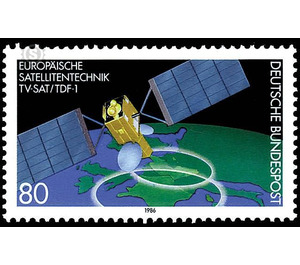European satellite technology - Germany / Federal Republic of Germany 1986 - 80 Pfennig
Theme: Astronomy & Space
| Country | Germany / Federal Republic of Germany |
| Issue Date | 1986 |
| Face Value | 80.00 |
| Color | multi-colored |
| Perforation | K 14 |
| Printing Type | Six-color offset printing |
| Stamp Type | Postage stamp |
| Item Type | Stamp |
| Chronological Issue Number | 1163 |
| Chronological Chapter | GER-BRD |
| SID | 976091 |
| In 45 Wishlists | |
With the launch of the German broadcasting satellite TV-SAT as part of a Franco-German joint project, the impressive advances in satellite technology and the performance of European industry in this high-tech field will be brought into the limelight. Satellite communication has a longer history. As early as the end of 1945, the American Arthur C. Clarke published a scheme of how to realize world-wide communications with 3 satellites distributed over the equator. Condition is that the orbital velocity of the satellites corresponds to the earth's rotation; d. h., the satellites are virtually silent over the earth. The distance from the earth is about 36,000 km. In 1965, the first satellite, called "Early Bird", was placed in such a "geostationary" orbit. This started the era of news satellites. From the very beginning, European satellite technology played a prominent role in the development of international and national projects. The Intelsat, Inmarsat and Eutelsat satellite systems are major milestones in the development of a high-performance European satellite industry. Again and again, new, groundbreaking solutions for the entire satellite technology were found, such as The 3-axis stabilization to maintain the trajectory and attitude of the satellite, which was realized for the first time in the Franco-German project "Symphony". Another outstanding example of the state of European satellite technology is the satellite TV-SAT. This project is a true first in the field of broadcasting satellites in terms of satellite performance and applied technical solutions. Broadcast satellites are high-performance satellites whose radiated transmit power is about 10 times higher than for telecommunications satellites. This makes it possible to receive broadcasts with comparatively small parabolic mirrors with a diameter of 60-90 cm in the "own house". The plans for a broadcasting satellite project had already begun in the 1970s. On 29/04/80 a Franco-German agreement was concluded on the development, production and launch of two direct broadcasting satellites, one of which is for the territory of the Federal Republic of Germany ("TV-SAT") and the other for the territory of the French Republic ( »TDF 1«). Both satellites are largely identical; they each have a capacity of 4 TV channels, whereby up to 16 stereo radio programs can be transmitted via a TV channel. The French satellite is to be put into orbit a few months after TV-SAT. The industrial work is mainly divided between the two contracting states Germany and France. However, other European countries are also involved in subcontracting the project. The launch of the satellite takes place with the European launcher "Ariane" of Kourou in French Guiana. (Text: Federal Ministry of Posts and Telecommunications, Bonn)


